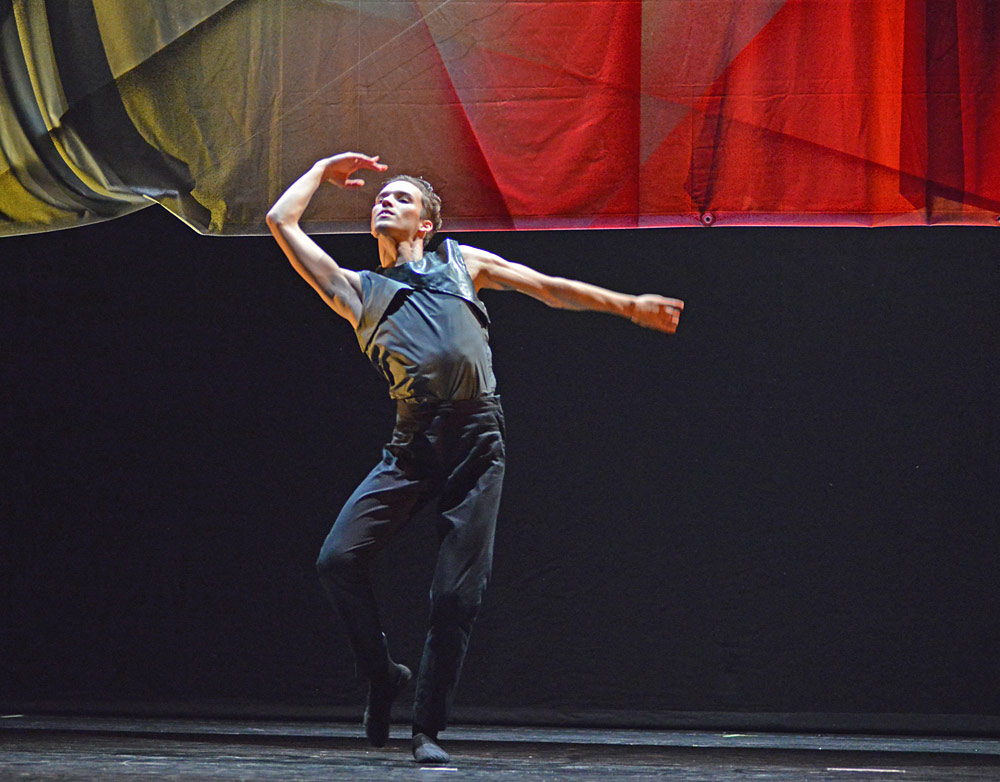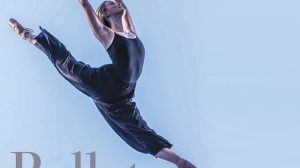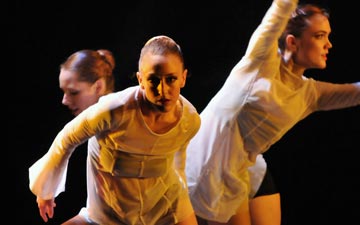
© Dave Morgan. (Click image for larger version)
New English Ballet Theatre
Quint-Essential bill: Land of Nod, Strangers, Moonshine, Enticement’s Lure, Vertex
★★★✰✰
London, Peacock Theatre
9 November 2016
Gallery of pictures by Dave Morgan
www.nebt.co.uk
peacocktheatre.com
New English Ballet Theatre (NEBT) is an apprenticeship company for dancers and has the praiseworthy aim of developing new young talent including choreographers and musicians. It was founded in 2012 by Karen Pilkington-Miksa and she has a firm commitment to commissioning new work. So here at the Peacock we have five new works from different choreographers, with mostly live musical accompaniment, performed with an attractive, open-hearted verve by the company of fourteen. Some of these pieces are more successful than others but the dancers seize the opportunities with relish and we should celebrate the existence of such a laudable enterprise which exists without public funding.
Three of the choreographers come from the Royal Ballet where they have previously made studio works under the First Drafts scheme, and this programme has a family resemblance to those events but with more stylish production values. George Williamson has previously worked with English National Ballet. The fifth is Daniela Cardim Fonteyne, a former dancer with Dutch National Ballet, who has worked with NEBT for a few years. She is now Company Manager and it was her work, Vertex, which closed the show.
Vertex seemed to encapsulate a number of NEBT’s virtues. The music, an unfamiliar choice, Camargo Guarnieri’s String Quartet No. 2, was played live by the Gildas Quartet. The costume designs were uncomplicated but elegant, grey with red flashes, and the backdrop artwork featured abstract grids with streaks of colour for each of the three sections. The work used a conventional ballet vocabulary and didn’t necessarily break new ground, but was well tailored to its cast. The eight dancers zipped through it with energy and purpose and it made the most of their youthful verve and vitality. After a more sombre middle section, the final movement provided a lively and upbeat conclusion, popular with the audience.

© Dave Morgan. (Click image for larger version)
Each item was preceded by a short introductory film of the choreographer describing their intentions, sometimes including how the piece was commissioned or the rationale for choosing the music. Often this is helpful but there is an art to giving just the right amount of information. Kristen McNally is an old hand at this and tells us just enough about her piece Moonshine to pique our interest but she firmly refuses to tell us what the “world” of the work is: she thinks it’s up to us to decide for ourselves. George Williamson on the other hands tells us at length that there is an explicit narrative in his Strangers about stages in the breakdown of a single relationship shown by three different couples. So it then becomes a bit of a disappointment when that isn’t readily apparent from what we see on stage.
Moonshine is another of McNally’s witty and idiosyncratic pieces. She has made several works for the smaller spaces at the Royal Opera House, and previous works for NEBT including the very popular Mad Women. One can only wish that the Royal Ballet would give her greater opportunities, and it would be great to see an entire evening of her works.
Here all her dancers are dressed in the same loose stripy pyjamas and trainers. The language looks quite simple, with individuals each having quirky, almost robotic movements – gestures of the hands and lunges – but as these are passed around and repeated it builds up to a more complicated picture. The dancers don’t perform as conventional couples. There is a pair of women, a pair of men and two mixed couples. The music is the soundtrack from the film The Grand Budapest Hotel and the dance becomes folk-inflected as the music moves to a burst of eastern European-sounding strings. One tall man picks up two women and swings them around him like a strongman in a circus.
So taking up Kristen’s challenge, who do we think the performers are and in what situation? It’s all delivered completely deadpan. Are they (in their stripes) a 1930s chain gang going through the motions? Why, part way through, are they joined by two more with the man pushing the woman along the floor as if he’s using her as a broom? It’s amusing (though not as funny as her previous pieces) but with a slightly sinister undercurrent to it all. This is reinforced by the ending where a single dancer gesturing in the spotlight looks at us apprehensively, pleading with us in some way.
Williamson’s Strangers is conventionally balletic with its three couples drifting on and off. It has a striking lighting installation with hundreds of bulbs hanging above the dancers at various heights, moving and illuminating them at various points in the ballet. The lighting is arresting but in the end this makes more of a lasting impression than the rather generic dancing. Given that it is meant to tell a story there doesn’t seem to be much attempt at characterisation.

© Dave Morgan. (Click image for larger version)
The Royal Ballet’s Valentino Zucchetti has produced works for NEBT before and seems very happy working in the classical idiom. His work Enticement’s Lure gives its five dancers some of the most testing dancing opportunities of the evening. An affectionate couple are split up by the personifications of desire in terms of a man in black and a woman in red. It all ends predictably unhappily as the betrayed woman can’t find happiness with anyone else.
Zucchetti asks a lot of his dancers and they worked hard here. His leading man in black leaps and spins athletically, but also slithers and insinuates himself between the couple to form an intricate trio. The music is Trio Elegiaque No. 1 in G Minor by Rachmaninoff, performed live by pianist Anne Lovett. Having the banner artwork at the back of the stage slowly crumpling and collapsing as relationships go astray is a nice touch. But having the female figure of temptation in a red dress is really a bit too obvious.

© Dave Morgan. (Click image for larger version)
Marcelino Sambé provided the opening work which got a very positive reception. Land of Nod, his first work for NEBT takes dreams and the surreal as its subject. One woman, the much-put-upon Hannah Sofo, is stalked by two men, lifted and entwined in some intricate trios, before waking and returning to domesticity to a third. She looks vulnerable but not so intimidated that she can’t push back. One man gives her a silver balloon, the other promptly bursts it in a neat invocation of that weird logic that dreams possess. Some lifts are complex and demanding, carried off well by the cast, if the work may be slightly too long. Overall the programme was uneven in terms of choreography but executed with attractive energy and verve.

















You must be logged in to post a comment.